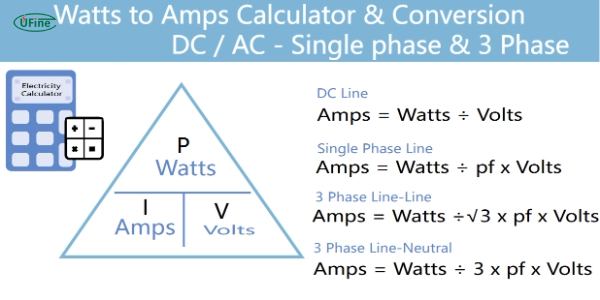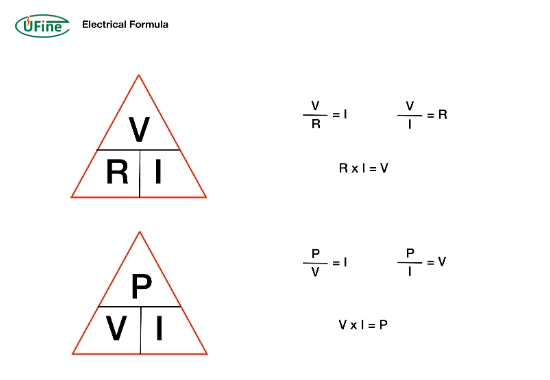Understanding how to convert watts to amps is essential for anyone with electrical systems. Whether setting up a new appliance, designing a circuit, or simply trying to understand your home’s electricity usage, knowing how these two measurements relate can help you make informed decisions. This guide will take you through the basics of watts and amps, the formulas needed for conversion, common mistakes to avoid, and practical applications of these conversions.
Part 1. What are watts and amps?
Watts (W) and Amps (A) are fundamental concepts in electricity.
Watts measure electrical power, which indicates how much energy is being used or produced over time. For example, a light bulb rated at 60 watts consumes 60 watts of power when it is on.
Amps, or amperes, measure the flow of electric current. You can visualize amps as the amount of water flowing through a pipe: the larger the pipe (or higher the amps), the more water (or electricity) can flow through.
Understanding these two units is crucial because they help determine how much power your devices consume and how much current they draw from your electrical system.
Amp Hours to Watt Hours: What is the Difference?
Part 2. Why convert watts to amps?
Converting watts to amps is essential for several reasons:
- Safety: Knowing how many amps a device uses helps prevent circuit overloads, which can lead to dangerous situations like electrical fires.
- Compatibility: When connecting devices to power sources, ensuring that the amperage matches what the circuit can handle is essential. This prevents damage to both devices and circuits.
- Efficiency: Understanding these conversions can help optimize energy use, leading to lower electricity bills and a smaller carbon footprint.
Part 3. The basic formula for converting watts to amps
You can use a simple formula derived from Watt’s Law to convert watts to amps. The basic formula is:
I (A) = P (W) / V (V)
Where:
- I = Current in Amps
- P = Power in Watts
- V = Voltage in Volts
This formula tells you that to find the current in amps, you divide the power in watts by the voltage in volts. This relationship is crucial for understanding how much current your devices will draw from a power source.
Part 4. Example calculations for watts to amps conversion
Let’s look at some practical examples to illustrate how this conversion works:
Example 1: Standard Household Circuit
Imagine you have a device that consumes 1200 watts on a 120-volt circuit. To find out how many amps it draws, you would use the formula:
I = 1200 W / 120 V
Calculating this gives:
I = 10 A
So, this device draws 10 amps from the circuit.
Example 2: Higher Voltage System
Now consider an appliance that uses 2400 watts on a 240-volt circuit. You would calculate it like this:
I = 2400 W / 240 V
This results in:
I = 10 A
Again, this device also draws 10 amps, showing how voltage affects the current draw.
Part 5. Converting watts to amps in AC circuits
The formula changes slightly in alternating current (AC) systems—common in homes and businesses—because of the power factor (PF). The power factor accounts for efficiency losses in non-resistive loads like motors or transformers. The formula becomes:
- I (A) = P (W) / (V (V) × PF)
For example, if your device has a power factor of 0.8 and it consumes 1000 watts on a 120-volt circuit:
I = 1000 W / (120 V × 0.8)
Calculating this gives:
I = 10.42 A
This means this device draws slightly more than 10 amps due to the power factor.
Part 6. Understanding three-phase systems
When discussing electricity, it’s essential to understand a three-phase system. A three-phase system consists of three separate alternating currents offset by one-third of a cycle from each other. This configuration allows for more efficient electricity transmission over long distances and is commonly used in industrial applications.
Due to their complexity, the formulas for converting watts to amps in three-phase systems are slightly different. For line-to-line voltage, the formula is:
- I (A) = P (W) / (V_L-L (V) × PF × √3)
And for line-to-neutral voltage, it’s:
- I (A) = P (W) / (V_L-N (V) × PF × 3)
These formulas consider the additional factors involved in three-phase power distribution, making them crucial for anyone working with industrial electrical systems.
Part 7. Common mistakes when converting watts to amps
While converting watts to amps may seem straightforward, several common mistakes can lead to incorrect calculations:
- Ignoring Voltage Levels: Always ensure you know whether you’re dealing with AC or DC voltage and use the correct voltage value.
- Neglecting Power Factor: You must account for power factor in AC systems to avoid significant calculation errors.
- Confusing Units: Be consistent with units; remember that 1 kW = 1000 W. Mixing up these units can lead to incorrect results.
Part 8. Practical applications of watts to amps conversion
Understanding how to convert watts to amps has various practical applications:
- Electrical Planning: When designing circuits or selecting breakers, knowing amp requirements helps prevent overloads and ensures safety.
- Appliance Management: Homeowners can better manage their electricity use by understanding how much current their appliances draw.
- Renewable Energy Systems: For solar panel installations or battery systems, accurate calculations ensure optimal performance and safety.
Part 9. FAQs
-
How do I determine if my circuit can handle additional devices?
To determine if your circuit can handle more devices, calculate the total amperage drawn by all devices and compare it with the circuit’s rating (usually 15 or 20 amps). -
What happens if I exceed my circuit’s amperage rating?
Exceeding your circuit’s amperage rating can cause breakers to trip or fuses to blow as a safety measure; however, it may also lead to overheating wires and potential fire hazards. -
Can I use any voltage rating when calculating?
No! Always use the correct voltage rating specific to your application—using an incorrect voltage will lead to inaccurate current calculations. -
What tools do I need to measure watts and amps?
You can use a multimeter or clamp meter to measure watts and amps in various electrical systems accurately. -
Is it necessary to consider temperature effects on amperage?
Yes! High temperatures can increase resistance in wires, which may affect current flow; thus, it’s essential to consider high temperatures when planning electrical installations.
Related Tags:
More Articles

LiPo Battery Discharge Rate Guide & Calculation Tips
Understand LiPo battery discharge rates, C-ratings, and how to calculate max current. Essential guide for RC, drones, and electronics users.
High‑Capacity 3S LiPo Batteries: 5000 mAh vs. 10000 mAh
Compare 3S LiPo 5000mAh vs 10000mAh batteries by weight, power, and use. Find the best fit for your drone, RC car, or boat setup.
Top 5 Applications for Small 3S LiPo Batteries
Small 3S LiPo batteries power drones, RC gear, wearables, and robotics with high energy and low weight. Making them ideal for compact electronics projects.
Building and Charging Your Own 3S LiPo Pack: A Step‑by‑Step Guide
Learn how to build, balance, and charge a 3S LiPo battery pack safely at home with this complete DIY guide for hobbyists and beginners.
How to Choose the Right LiPo Battery Plug Type?
Discover the best LiPo battery plug types, how to choose them, and expert tips for safe usage, soldering, and maintenance.





